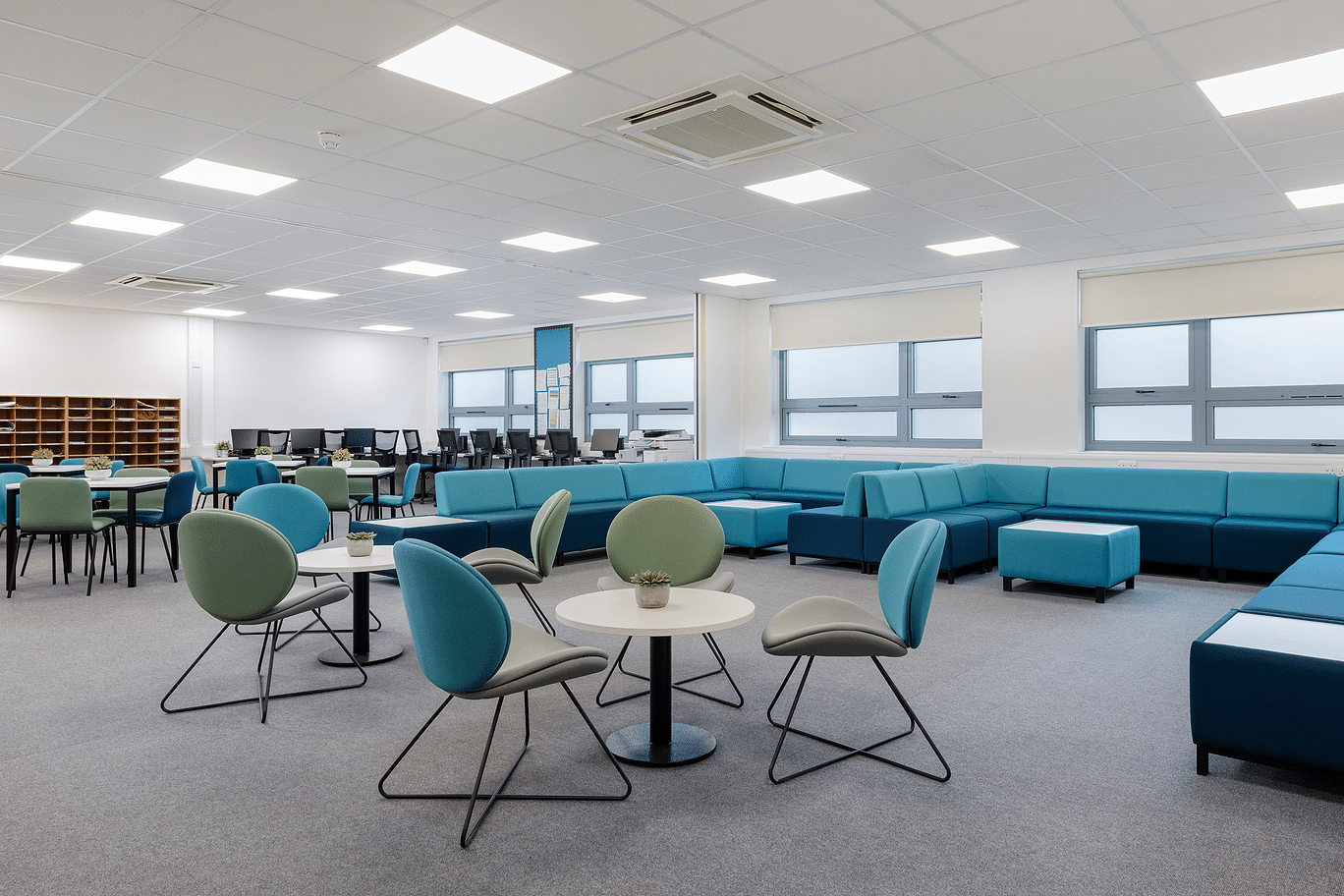The Power of Staff Rooms for Social Interaction and Collaboration
May 14, 2024 • 6 minutes

Well-designed staff rooms are essential for encouraging social interaction and collaboration in today’s fast-paced education environments. These places serve as hubs for creativity, interaction, and leisure rather than merely being rooms for taking a break. By making functional and design investments in staff rooms, schools may unleash the potential for higher output, happier teachers, and a more innovative team.
An effectively designed staff room offers a much-needed break, enabling teachers and teaching assistants to relax and rejuvenate. This area encourages informal conversation among colleagues, allowing them to bond and exchange ideas. A workplace that is more informal fosters knowledge sharing and the interchange of new ideas throughout departments, which makes work more creative and collaborative.
Creating a Welcoming and Comfortable Staff Room Environment
Make sure the staff room is welcoming and comfortable to encourage employees to use it in order to get the most out of it. To promote inspiration and relaxation, careful planning of the layout and design is essential. Adequate natural light, a variety of options, and comfortable lounging areas enhance positivity. Natural materials or plants that are suited for a biophilic design can intensify the relaxing and revitalising effects.
Equally vital is functionality. Incorporate features that meet a range of demands, like a refrigerator, microwave, and space for storing personal items, along with a fully furnished kitchenette or coffee station. These not only make things more convenient, but they also motivate everyone to stay in the room longer, which increases chances for teamwork and social interaction.
The Benefits of Social Interaction and Collaboration
Collaborating and interacting socially in staff rooms has several advantages for the school and its teachers. Peer connections improve engagement and job satisfaction by fostering a sense of belonging and thwarting feelings of isolation among staff members. Feeling connected and supported motivates employees to exceed expectations and actively contribute to the company’s success.
Another important advantage is collaboration. Staff rooms offer a casual, calm environment where teachers can cooperate and exchange expertise. This encourages the creation of creative solutions and ideas that might not surface in a more formal atmosphere. Collaboration also dismantles organisational silos and fosters an environment of candid communication and cooperation among all members of the team.
Designing an Inspiring Layout
It’s important to carefully balance form and function when designing a staff room layout to encourage social contact and provide specific areas for solitary work or rest. Different tastes and working methods can be accommodated by a range of seating alternatives, including cosy sofas, bean bags, high tables, and standing workstations. Flexible furniture arrangements allow for simple reconfiguration in response to changing group numbers or activities.
Positive effects are also possible with biophilic design components. Natural materials that evoke a sense of peace and closeness to the natural world are wood and stone. Not only may the addition of plants or green walls improve aesthetics, but they also improve air quality and offer a visual escape from the office setting.
And lastly, think about acoustics. Using sound-absorbing furnishings, such as carpets or acoustic panels, can help lower noise levels and foster a calmer environment. Include private or quiet spaces as well for concentrated work or phone calls.
Incorporating Technology for Enhanced Collaboration
In today’s collaborative workplace, technology is essential. Staff rooms can benefit from integrated elements that encourage effective communication. Digital displays or interactive whiteboards make it easier to share and brainstorm ideas, while video conferencing lets distant team members communicate with one another. Install, high-speed internet and charging stations also guarantee that teachers remain connected and productive.
The idea is to strike a balance between technology and interpersonal communication. Although technology facilitates collaboration, in-person encounters should still take precedence over it. The staff room’s layout should gently encourage putting electronics away to promote a more intimate exchange.
Promoting Employee Well-Being Through Amenities
A positive work environment is contingent upon the well-being of its employees. Staff rooms can make a big difference by providing amenities that encourage rest and physical and mental well-being. There are places to relax and decompress, such as pleasant corners, massage chairs, or comfortable seating areas. Having access to wholesome fruits, snacks, and drinks promotes making good decisions all day long.
Lighting has an impact as well. Thoughtfully planned artificial and natural lighting creates a pleasant and uplifting atmosphere, positively impacting energy and mood.
Take into consideration adding wellness programmes to the staff room for a more comprehensive strategy. Employers can provide resources that support stress management and work-life balance, as well as mindfulness workshops and yoga or meditation sessions. Employers show their dedication to a positive and healthy work environment by valuing well-being and offering these services.
Case Study on Successful Staff Room Designs
Acknowledging the importance of employee well-being and teamwork, the esteemed independent school Queen’s College renovated its staff lounge. To create a cosy and welcoming area, they added fresh lighting, soft furniture, and carpeting. In order to accommodate a variety of work methods and pay homage to the college’s rich history and traditions, the design discreetly integrates the insignia into the layout. The result is a highly engaging and inspiring space where staff can relax, recharge, and connect with their colleagues.
How to Encourage Teachers to Utilise the Staff Room
Designing a great staff room is just the first step; encouraging its use is crucial. Here’s how: clearly communicate the purpose and benefits to employees through company announcements, email newsletters, or internal platforms. Share success stories or testimonials highlighting how others have benefited.
Foster a positive staff room culture. Lead by example—use the space yourself! Organise team-building activities or events like lunch-and-learns or social gatherings within the staff room. By integrating it into the company culture, employees will naturally gravitate towards the space and its advantages.
Measuring the Impact of Staff Rooms on Productivity and Employee Satisfaction
Staff can utilise a variety of techniques to gauge how staff rooms affect output and worker satisfaction. Employee surveys, focus groups, and feedback sessions can reveal staff usage patterns, activities, and perceived benefits of the space. Furthermore, monitoring indicators such as changes in worker productivity before and after improvements, collaboration rates, and job satisfaction scores yields insightful data.
Employers can have a thorough grasp of how staff rooms affect workers’ general happiness, productivity, and well-being by studying this data. This information aids in updating the staff room’s facilities and layout in the future to better meet the evolving needs of the workforce.
Unlocking the Potential of Staff Rooms for Social Interaction and Collaboration
Workplaces could be revolutionised by a well designed staff room. We can transform these areas into creative hubs that foster social interaction, teamwork, and worker well-being, thereby igniting creativity, productivity, and satisfaction. Staff rooms may become dynamic hubs for connection, renewal, and idea generation with careful design, technological integration, and attention to worker well-being. When implemented with the right strategy, staff rooms can significantly transform the workplace.
If you’re ready to take the next step or need assistance in bringing your vision to life, contact Westcountry Group today to find out more — call 0330 030 0330 to discuss your project with our educational interior design team, email: sales@westcountrygroup.com or visit https://www.westcountrygroup.com/education.
Let us help you transform your environment into inspirational spaces that optimise learning and enhance student performance.






